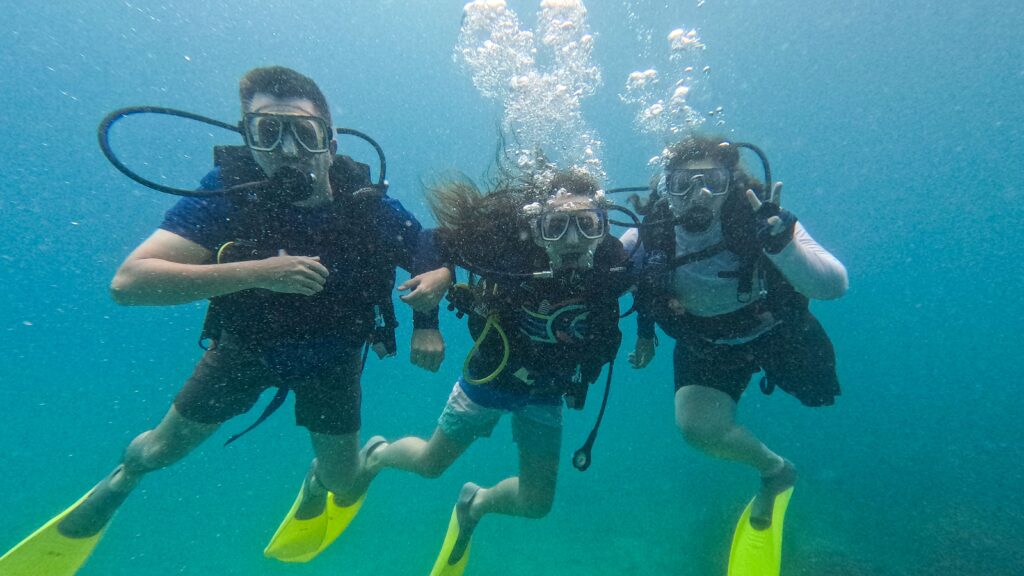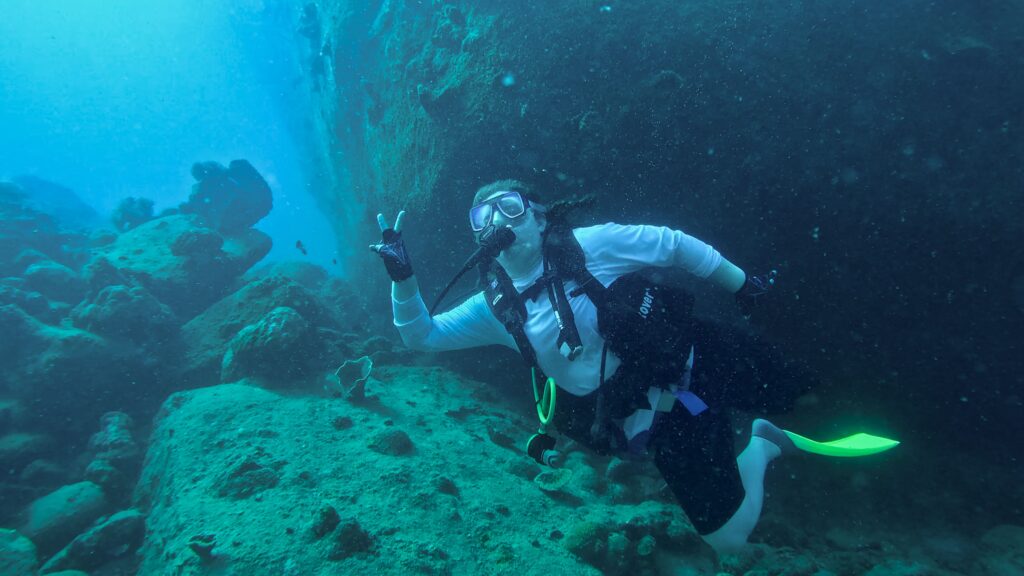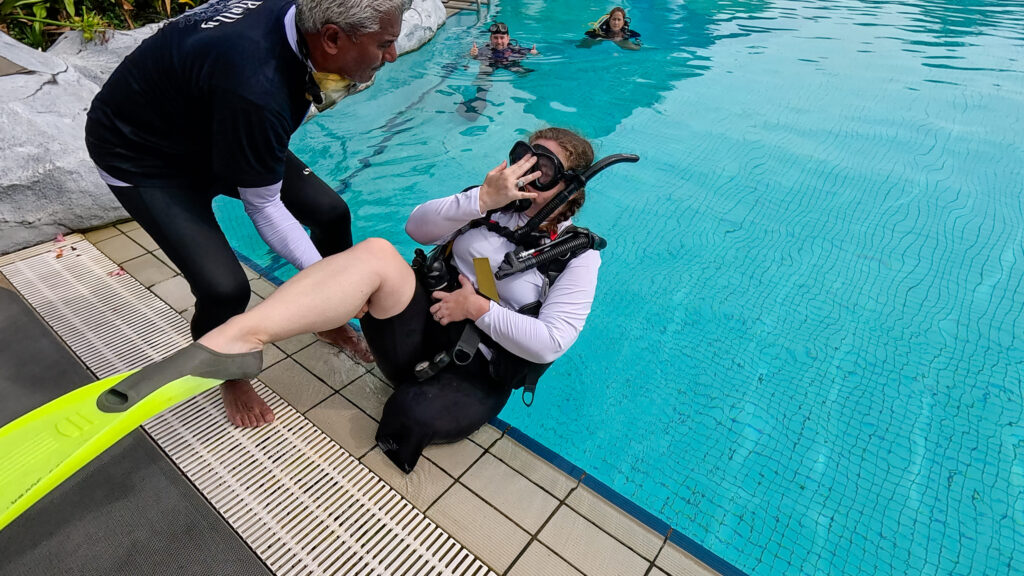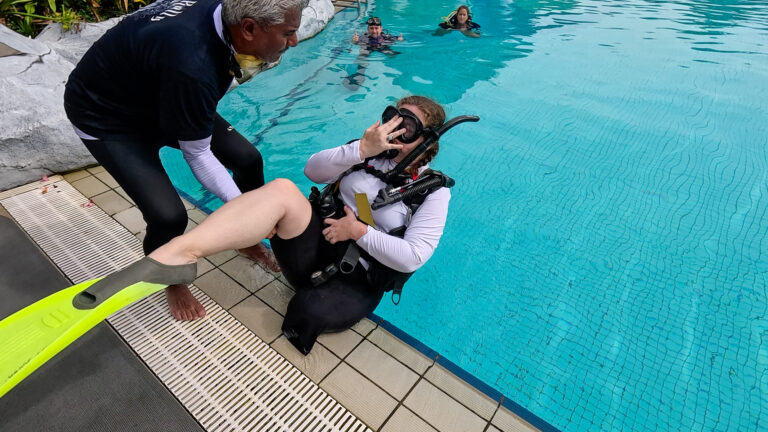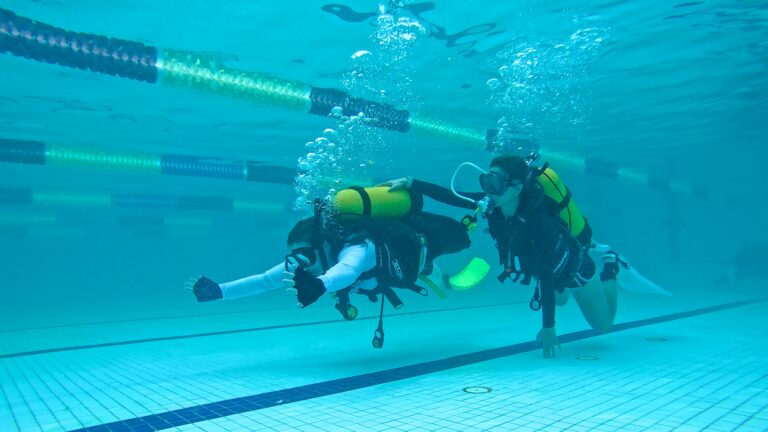By Jodi St. Clair
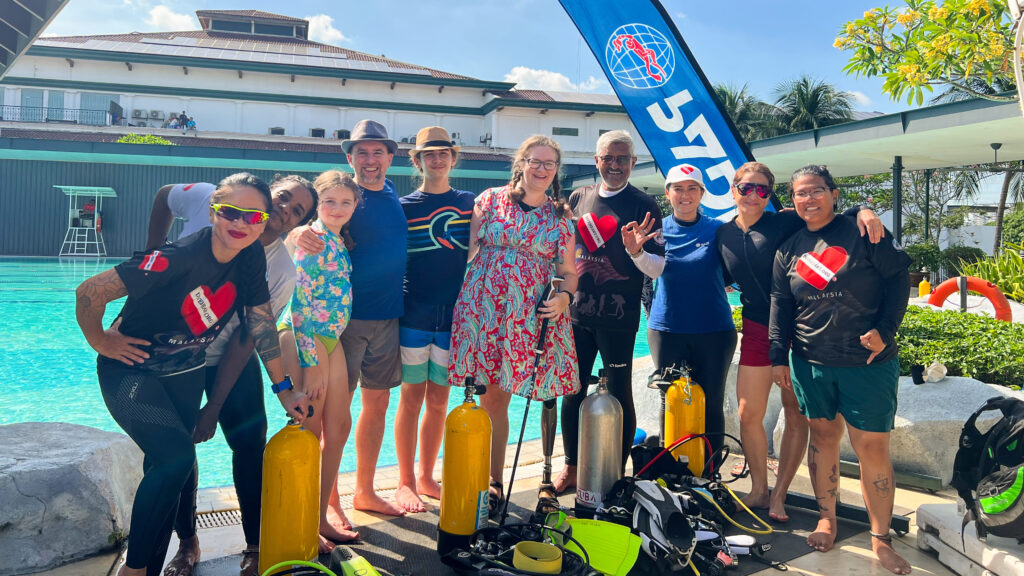
Listen to this Article
When you have a disability, this is what it’s like to go through dive training.
On our second day of diving, the moment we’d been hoping for happened. Our first day of open water adaptive scuba training had taken us to anemones teeming with clownfish. Rays had rippled along the sandy bottom of the waters off Pulau Perhentian Kecil, or Lesser Perhentian Island, off the northeastern coast of Malaysia.
Now, as my husband and daughter flipper-kicked behind me, a large green sea turtle scratched its back on a coral overhang just above the sea floor. I watched the turtle, and as I flicked the one fin on my one foot, the turtle watched a mermaid.
And this moment, this dive, was all possible because an adaptive program taught me to scuba dive as an amputee.
When I was 13, an osteosarcoma, or bone cancer, diagnosis resulted in my left leg being amputated at mid-thigh. I’ve now been an above-knee amputee for 30 years. Along with my husband Anthony, 10-year-old daughter Aster and 13-year-old son Connor, we began traveling full time in 2022, including 13 countries and 26 states in our home country of the U.S.A.
While we love kayaking, swimming, and snorkeling, we wanted to get to know the world beneath the waves too. But how would a one-legged amputee like me complete scuba training and certification?
Our search for accessible training options led us to the Open Water course offered by the Professional Association of Diving Instructors, or PADI. Since 2017, PADI has offered an Adaptive Techniques Specialty course, which helps dive instructors adapt dive training for people who have physical and/or mental disabilities.
One dive center that has made adaptive training a core part of its offerings is Kids Scuba, located in Kuala Lumpur, Malaysia. Since 2004, founder and director Syed Abd Rahman and his instructor team have specialized in training not only children and teens, but people with disabilities, including amputees.
“When a person has a disability, in water sports you can move freely,” explains Rahman.
In addition to training our family to dive at the Kids Scuba PADI Adaptive Facility at the Tropicana Golf & Country Resort in Petaling Jaya, Rahman trained Anthony to be an Adaptive Support Diver. This training encompasses similar techniques and processes instructors complete so they can offer Adaptive Service Training.
“Adaptive speciality training is a new ball game for instructors,” says Rahman. “They gain a sense of having a disability through role play. You go through being a single-leg or single-hand amputee. How do you move? How do you adjust your mind positively? How do you move without the use of hands or legs? This is where qualified adaptive assistance comes in. They need to know what to do.”
Exercises with blindfolds or bound limbs build awareness and empathy, as divers simulate having a visual impairment, use of one arm, use of one leg, use only of upper body, and use only of head motion. Training includes different signals, guidance, and communication, along with treating divers of all abilities with respect and an attitude that it’s not about adapting the diver to diving, but adapting diving to the diver.
“We set a boundary during the adaptive training, in which we inform all divers, instructors, and dive professionals of what they need to do and what they need to discuss with the person who has a disability,” explains Rahman. “We instructors adapt to the environment, to the situation, to the diver.”
Open Water dive training typically has three stages:
(1) An e-learning course through the PADI website, which you complete in advance at your own pace (we found it useful for both us adults and kids to complete training modules piece by piece over two weeks).
(2) Two days of Confined Water training, often completed in an enclosed swimming pool
(3) Three days of Open Water training, with supervised team dives in the ocean
During Confined Water, our kids trained separately with their own instructors, while Rahman and his assistants worked with me and Anthony on procedures, gear, signals, and being in the water.
“The instructors learn when to give assistance and when to give space,” notes Rahman. “We discuss upfront what we do, what needs to be done, and how we can assist. That evolves as the diver learns, and as everyone understands each other better.”
To complete our Open Water training, we later traveled to the Perhentian Islands. The calm waters here teem with coral and sea life. During our stay at the MIMPI Perhentian Resort, we completed our Open Water training not only with the Kids Scuba team, but with the instructors and guides at Below The Surface Divers (BTS).
“Confined water is for skills. When you hit open water and a diver feels the salt water for the first time, don’t push on skills. Let them relax and enjoy the water first,” says Rahman. “The main physical and mental part of open water is experiencing marine life. Diving in a place like a jetty at MIMPI, on a clear water day you might see five species of fish alone.”
When doing water recreation, I leave my prosthetic leg in a secure area and get around on crutches. Our first dives were from shore, so I crutch-walked from the dive center to the beach below. Once in water shallow enough for me to stand, I handed my crutches to someone who took them to the dive center, had help putting on my dive gear, then swam over to where we’d begin and end our dives.
Our second day’s two dives were from a boat. I practiced going up and down the boat ladder without my gear. On board, I then donned my dive gear, and our guide supported me for back roll entries into the water.
Once in the water, my disability didn’t matter.
I felt like a mermaid, flicking my one flipper. Webbed gloves made my underwater hand strokes more effective. I practiced my rhythm of hand stroke, glide, and kick that Rahman had suggested as a good match for my ability.
“Adaptive instructors have to go through different swim techniques so they can match the right technique to the diver,” explains Rahman. “If you are a single-leg amputee like Jodie, she will eventually learn and adapt to the dolphin kick, but she still needs to move with her hands. Hand movements across the world usually follow a breaststroke technique.”
Along with my family and our dive team, we dove alongside coral and fish, rays and, yes, that large, beautiful green turtle.
Later that evening, the Kids Scuba and Below The Surface teams presented us with our Scuba Diver, Junior Open Water, and Open Water certifications.
We were officially a family of divers.
I had added a new skill set, along with new opportunities for enjoying and appreciating nature, to my life and my abilities. Our family also gained major motivation to dive, and we are adding dives to more of our travels.
After all, diving can be adapted to a range of mobilities and conditions. Under the waves, adaptive dive training can open a sea of opportunity to people of all abilities, just as it did for this mermaid and her family.
Disclosure: Training and Perhentian Island lodging were provided by PADI, Kids Scuba, Tourism Malaysia, Below The Surface Divers, and MIMPI Perhentian Resort.
Jodie and Anthony St. Clair are the Learners and Makers.
They empower families and people with mobility disabilities to travel confidently, their way.
Check out their guides, videos, and more at learnersandmakers.com.
Adaptive Diving Resources
PADI: padi.com
Find adaptive diving service facilities: padi.com/adaptive-service-facilities
Kids Scuba, Malaysia: padi.com/dive-center/malaysia/kids-scuba
Diveheart adaptive scuba for kids and adults with disabilities: diveheart.org

